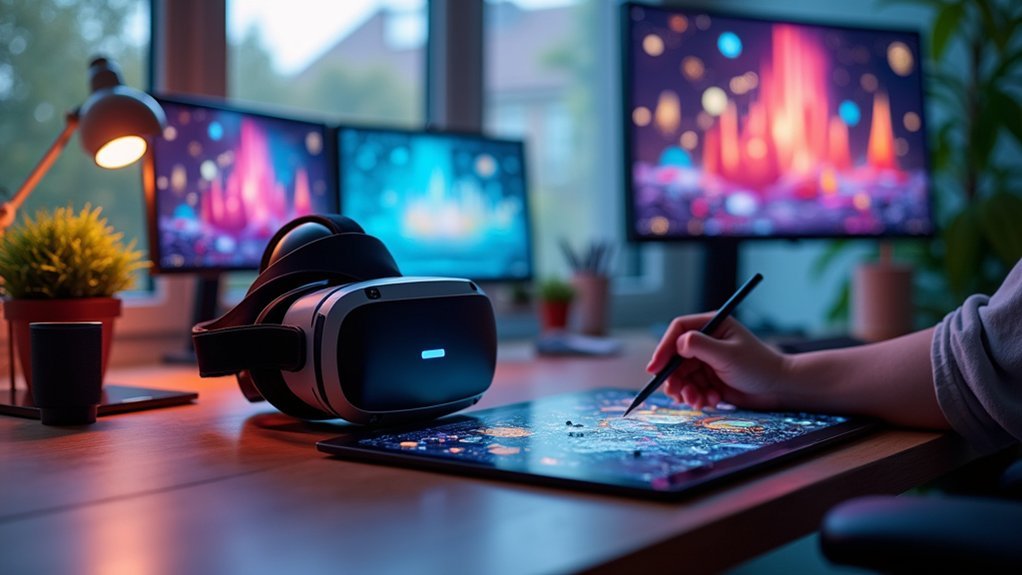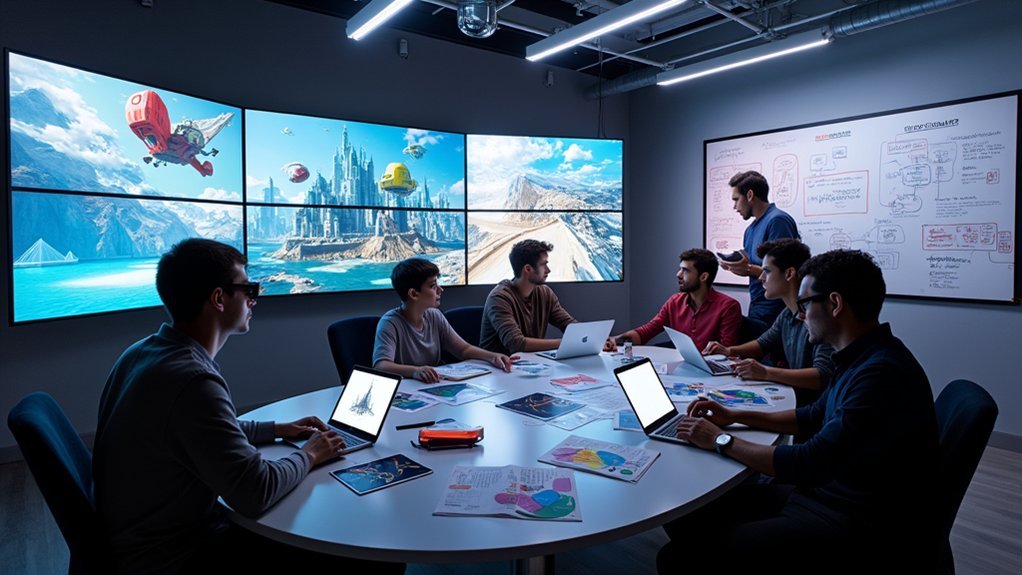You’ll expand your creative content library by leveraging VR-specific asset creation tools like Unity and Blender for immersive experiences that captivate audiences. Build cross-platform ecosystems that amplify your brand reach through interconnected touchpoints, ensuring consistent visual identity while repurposing successful content across multiple formats. Implement streamlined collaborative workflows using cloud-based platforms and project management tools to coordinate teams effectively. These strategies transform basic collections into dynamic, multi-platform powerhouses that maximize engagement and impact across your entire creative network.
Leverage VR-Specific Asset Creation Tools for Immersive Content Development

When you’re developing immersive VR content, specialized asset creation tools become your gateway to crafting experiences that truly engage users in three-dimensional space.
VR asset creation tools like Unity and Unreal Engine provide robust platforms for building immersive environments, while Blender and Tilt Brush enable direct 3D modeling within virtual space.
You’ll accelerate your content development by utilizing pre-made models from asset libraries like Sketchfab or TurboSquid.
Focus on VR-specific design principles that prioritize user comfort and spatial awareness to create truly engaging content.
Real-time rendering capabilities offer immediate feedback, letting you make instant adjustments that enhance content quality.
These tools transform your creative workflow, ensuring your projects deliver exceptional immersive experiences.
Build Cross-Platform Content Ecosystems for Maximum Reach and Engagement
Building a cross-platform content ecosystem amplifies your reach by creating interconnected touchpoints where your audience can discover and engage with your brand across multiple channels.
Cross-platform content ecosystems create powerful interconnected touchpoints that amplify brand reach and drive meaningful audience engagement across multiple channels.
This strategic planning approach transforms your content library into a powerful network that drives brand awareness.
To maximize your content creation process effectiveness:
- Map your audience journey across platforms to identify ideal content calendar placement for different content formats.
- Track engagement metrics to determine which channels generate greatest conversions for specific content types.
- Maintain consistent visual identity so community members instantly recognize your high-quality content anywhere.
- Repurpose successful content into multiple formats—transform blog posts into videos, infographics, and social media snippets.
Analytics-driven distribution guarantees you’re allocating resources where they’ll generate peak impact while interactive elements boost participation rates considerably.
Implement Collaborative Workflows to Streamline Virtual Reality Content Production

Virtual reality content production demands sophisticated coordination between creative teams, technical specialists, and project stakeholders to deliver immersive experiences that captivate audiences.
You’ll streamline your workflow by establishing clear roles for team members and leveraging project management tools like Trello or Asana to track progress across different content formats.
Implement cloud-based platforms that enable real-time collaboration on your content library, allowing artists, developers, and marketers to contribute seamlessly regardless of location.
Schedule regular check-ins to address challenges and enhance your creative process through cross-functional brainstorming.
These collaborative workflows transform content production from chaotic coordination into efficient teamwork, ensuring your virtual reality projects maintain quality while meeting deadlines and maximizing your team’s diverse expertise.
Frequently Asked Questions
How Often Should Creative Teams Schedule Brainstorming Sessions for New Content Ideas?
You should schedule brainstorming sessions weekly or bi-weekly to maintain creative momentum. Don’t let gaps exceed three weeks, as you’ll lose inspiration flow. Regular sessions keep your team engaged and guarantee you’re consistently generating fresh, innovative content ideas.
What Budget Considerations Are Essential When Expanding a Creative Content Library?
You’ll need to allocate funds for content creation tools, freelancer fees, stock media licenses, and production equipment. Don’t forget ongoing subscription costs for software, storage solutions, and potential talent acquisition expenses.
How Do You Measure the ROI of Different Content Formats and Types?
Track engagement metrics, conversion rates, and revenue attribution for each content type. You’ll compare cost-per-acquisition, lifetime value, and organic reach across videos, blogs, infographics, and social posts to identify your highest-performing formats.
What Are the Best Practices for Organizing and Categorizing Creative Assets?
You’ll want to create a folder structure by content type, campaign, and date. Use consistent naming conventions, tag assets with relevant keywords, and maintain a centralized digital library that’s accessible to your entire team.
How Can Small Teams Compete With Larger Content Libraries on Limited Resources?
You’ll maximize impact by repurposing existing content across multiple formats, collaborating with micro-influencers, focusing on quality over quantity, leveraging user-generated content, and strategically timing releases for maximum engagement.





Leave a Reply